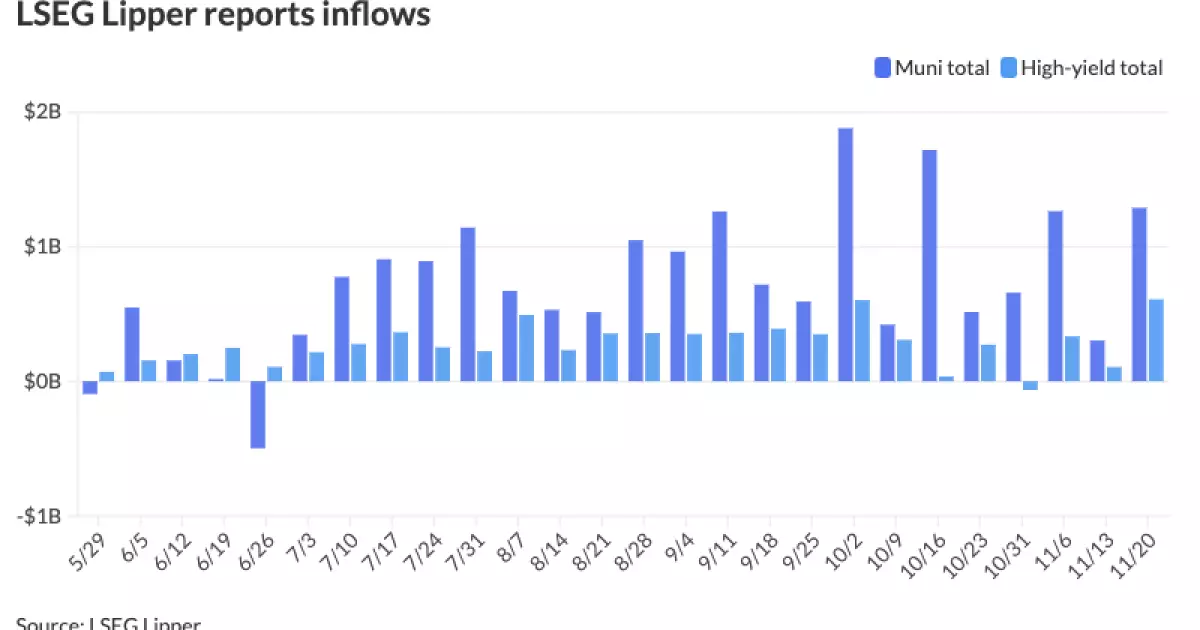The municipal bond market has shown a noteworthy stability in recent weeks, even as various factors influence investor behavior and market yields. As of Thursday, inflows into municipal mutual funds surpassed the monumental threshold of $1 billion, showcasing a sustained interest from investors. This resilience, highlighted by inflows of $1.288 billion in just one week according to data from LSEG Lipper, marks a striking counterpoint to the fluctuations observed within the broader financial landscape.
The significant inflows into municipal bond mutual funds—up from $303.2 million the previous week—illustrate a robust demand for municipal securities, continuing a remarkable streak of 21 consecutive weeks of positive inflows. High-yield municipal funds particularly demonstrated an impressive appetite from investors, recording inflows amounting to $608.9 million, a substantial increase from the prior week’s $150.3 million.
As yields in the U.S. Treasury market rose, particularly in shorter maturities, the relative stability of municipal bond yields remained influential for high-net-worth investors. The notable ratios of municipal to U.S. Treasury yields—60% for two-year bonds and 82% for 30-year bonds—indicate a favorable landscape for those seeking tax-efficient investment vehicles amidst rising rates.
Despite an overall light issuance calendar this Thursday, the few large deals that did come to market were well received. Portfolio manager Brad Libby from Hartford Funds pointed out that various municipal offerings, particularly those with A or AA- ratings, enjoyed an oversubscription of five to ten times the available amounts, often resulting in slight adjustments to their yields during reallocation. This is a clear indicator of the high demand that exists within the municipal bond market.
Recent noteworthy issuances included the $520 million Grand Canyon University Project from the Maricopa Industrial Development Authority and a $100 million health care revenue bond series from the Charlotte-Mecklenburg Hospital Authority. The enthusiastic market reception to these larger issues underscores a broader investor confidence and the underlying strength of municipal finance.
Looking Ahead: Potential Market Shifts
As we approach the Thanksgiving holiday, municipal bond supply is expected to contract significantly, with Bond Buyer reporting a 30-day visible supply of $5.58 billion. Libby anticipates that the remainder of the year could yield an additional $25 billion to $35 billion in new issuances, predominantly concentrated in the weeks following Thanksgiving.
Interestingly, while external factors such as upcoming Federal Reserve meetings and geopolitical events loom large on the horizon, recent elections have thus far not dramatically impacted the municipal market. Strategies employed by fixed-income strategists, such as Cooper Howard from Charles Schwab, suggest that the post-election environment remains favorable for munis, especially for investors in higher tax brackets. The allure of stable yields amidst rising Treasury rates adds to the appeal of municipal investments.
Strategists are keenly attuned to the Fed’s moves, particularly regarding the potential for rate cuts in the wake of inflation fears. The current market pricing implies an 80% probability of a 25-basis-point cut at the next Fed meeting in December, which could significantly impact fund flows and overall demand in the municipal bond market.
Moreover, the increase in CUSIP requests—a broadly recognized indicator of future issuance—suggests that municipal securities continue to attract attention. October saw a 25% increase in CUSIP requests compared to September, reflecting a robust development environment for municipalities. Texas, California, and New York led state-level demand, further solidifying the trend of increasing activity within the municipal bond arena.
This consistent upward momentum, particularly evident in municipal bond identifier requests, showcases a resilient marketplace that has adapted to recent challenges—emphasizing an overall positive trajectory in community-focused investments.
The municipal bond market’s current stance reveals a complex interplay of steady demand and strategic investor positioning against a backdrop of rising Treasury rates and anticipated Fed rate cuts. The upcoming months will be critical; with expected lower issuances and continued investor inflows, this sector offers compelling opportunities, particularly for those seeking the interplay of tax benefits and relative yield stability. As stakeholders remain attuned to both macroeconomic shifts and local municipal needs, the prospects for the municipal market appear increasingly optimistic.

